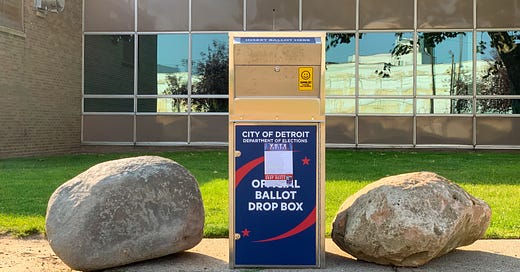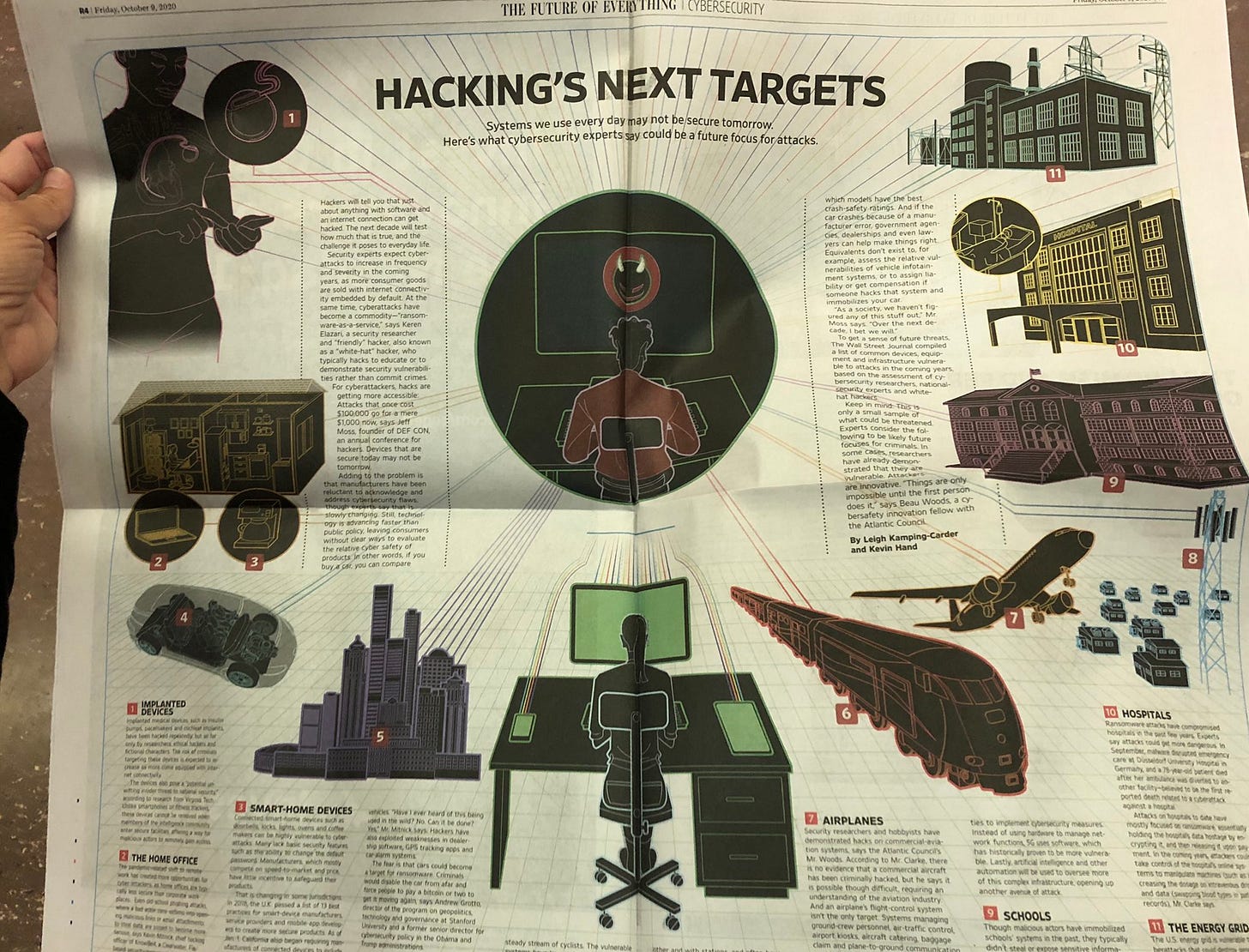If I had to use one word to describe 2020 it would be… risk. You thought it would be Zoom, didn’t you? Nope. As constant as your shadow and as confusing as a dream, risk is the theme of the year. That sounds stressful, and it can be, but risk can also be a useful searchlight. Today we’re looking for murmurs of perceived risk to see how they help us glimpse the future of cities, for better and worse simultaneously.
I’m Bryan Boyer, Director of the Urban Technology degree at University of Michigan. This newsletter is about cities, technology, and design. While we launch the program, we’re detailing the process of working toward the day when we welcome our first students, now 37 weeks and counting. Enjoy this newsletter? Send to a friend who may feel the same way. We appreciate it!
🗝 Follow the Worries
As a general rule, if something can be broken it will be by someone, somewhere. Indestructible dog toys? Shredded in seconds by my friend’s dog Princess Monkey. Ring’s flying home security camera, as discussed in a previous newsletter? It’s built-in security defenses will almost certainly be broken and those devices will at some point be used for purposes other than what Amazon imagined them for. That’s great if it’s benign or generative, and less great if it’s destructive and harmful.
Since humans are “loss averse” (they hate losing more than they like winning) the potential downsides of things loom large in our minds. Today’s Wall Street Journal provides a useful index of all of the new ways that hackers can infiltrate our lives:
Photo borrowed from Shannon Mattern. Thanks Shannon!
Threats to medical implants, airplanes, schools, power plants, and the heating and cooling system in your home are no joke. But think for a moment about what else this tells us. If people are worried about all of the potential downsides of hacking in the contexts outlined by the Journal, what could be done in those realms that’s more constructive? Yes we need to protect against the risks of hacking, but if something is hackable it is programmable and that means it can be repurposed, recontextualized, upgraded, and extended. We can follow the risks to find opportunities.
If public transit networks can be held digitally hostage for extortion, that means they also have the digital infrastructure (or the beginning of it) to be upgraded for more responsive and equitable routing. Who’s going to do that work alongside the deep security efforts conducted by folks like our friends at the UM College of Engineering?
If power grids can be shut down remotely by bad actors, that means they can also be proactively reconfigured into more resilient mesh networks that enable neighborhoods and communities to weather the vicissitudes of climate more successfully. Who’s going to do the work of designing the services and systems that neighbors use to self organize into microgrids?
Treat worries and risks with respect, yes, but stopping at “protection” is not good enough. We have to push past protecting digital systems to improving the way they work for and with humans. A classic move of design research is to follow the worries to find spaces of opportunity. In a world with this many risks, there are lots of places to get started!
🩹 Spot the Coping Mechanisms

When you pass a scene like this you are obliged to stop, get off your bike, and re-trace your steps to ponder what you see. Detroit is gearing up for an election that is beset with risk in numerous ways. Voting in person requires us to do the mental math of how much health risk we’re enduring and whether we can accept it. Voting by mail should be the easy answer to those health risks, but the public meltdown of the US Postal Service this summer has attached some serious questions to the reliability of vote by mail. Will the ballot make it there on time? Will it be subject to partisan shenanigans during validation and counting?
In response to this whole array of potential pitfalls, Detroit has placed ballot drop boxes outside all designated polling places. The one near my house is protected by two large boulders, which may seem odd if you’re not from here but it’s not uncommon to see boulders sitting in Detroit. The city’s General Services Department places large rocks around the perimeter of parks to keep cars out, without needing to resort to something like an unwelcoming fence. In this case the boulders are presumably to prevent someone from bashing into the ballot box.
The combined weight of these risks has turned the Department of Elections into accidental artists. What if instead of having to resort to unexpected sculpture like this ballot and boulder agglomeration we had other ways to vote that are native to the 21st century? We can bank online, visit the doctor online, pay a parking ticket digitally… why can’t we vote digitally?
There are, of course, lots of people working and thinking on this topic. One of my favorite ideas in the space is “Liquid Democracy, ” which has been advocated for by the Pirate Party in Germany (yes that’s a real political party). In Barcelona, Decidim is building software for communities to organize, contribute ideas, and collaboratively make decisions about how resources are spent. These are just two examples and there are stacks of others. Who is building those protocols, platforms, and tools? Who’s designing them to be socially appropriate and culturally sensitive? Maybe it should be you?
In the same way that hacking risks point us to sites of opportunity for future invention, current-day coping strategies like the accidental sculpture pictured above are visceral indicators of the processes where our society desperately needs thoughtful and careful work to move beyond the inherited means and methods of prior centuries. Getting good at spotting coping mechanisms is one of the tools we use to understand the relationship between people and urban systems. How does voting look in your city?
✏️ Postcard from Detroit

Last week we mentioned working with an illustrator. That’s Justine Allenette Ross and she’s super. The image above is a teaser from her work in progress. More on this soon.
Links
🕳 Some weeks ago we included a link to a building that was erroneously made super tall in Microsoft flight Simulator. This hole in the ground is even more wild.
🪑Are.na offers a meditation on tables. Cities are for people, which means cities are for relationships of all kinds. Where do relationships get cemented? Around tables, quite often. (How can there be no table emoji?!)
☀️ Researchers have built a solar-powered Gameboy. But does it have Untitled Goose Game?
🏞 What if we moved beyond land ownership? Dark Matter Labs, a fascinating global design practice, is thinking about new approaches to law and governance that enable systemic and spiritual connections to land.
🤖UM grads have launched a new autonomous delivery bot company and because it’s built in Michigan this robot can trundle through the snow. Go Rev-1!
📕 Meaningfully inefficient smart cities is the term coined by Eric Gordon. If you’re a regular reader of this newsletter and followed the discussion about buzzwords last week, Eric’s book is worth your time and he gave a great talk yesterday.
This week: Lots of conversations with the outside world, which is much needed. Recorded an interview with Benjie de la Peña about his work on transforming informal transit. 🤯 chat with Eric Gordon. Generous and thoughtful hour with a friend from industry in NYC about product management. Checked in with Steven Babitch, who works as a service and strategic designer in the Federal government and happens to be a UM alum. Kicked off the creative process with an animator for our video project. Lots of calls. Career counseling. Schedules. Admissions. Etc. 🏃♂️



